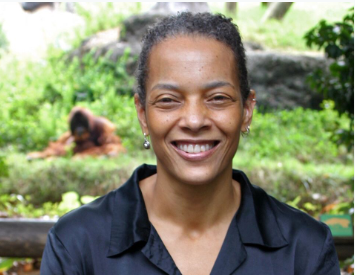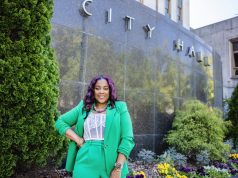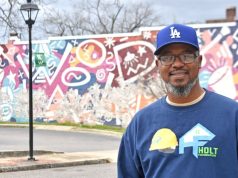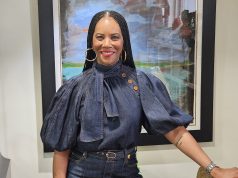By Erica Wright
The Birmingham Times
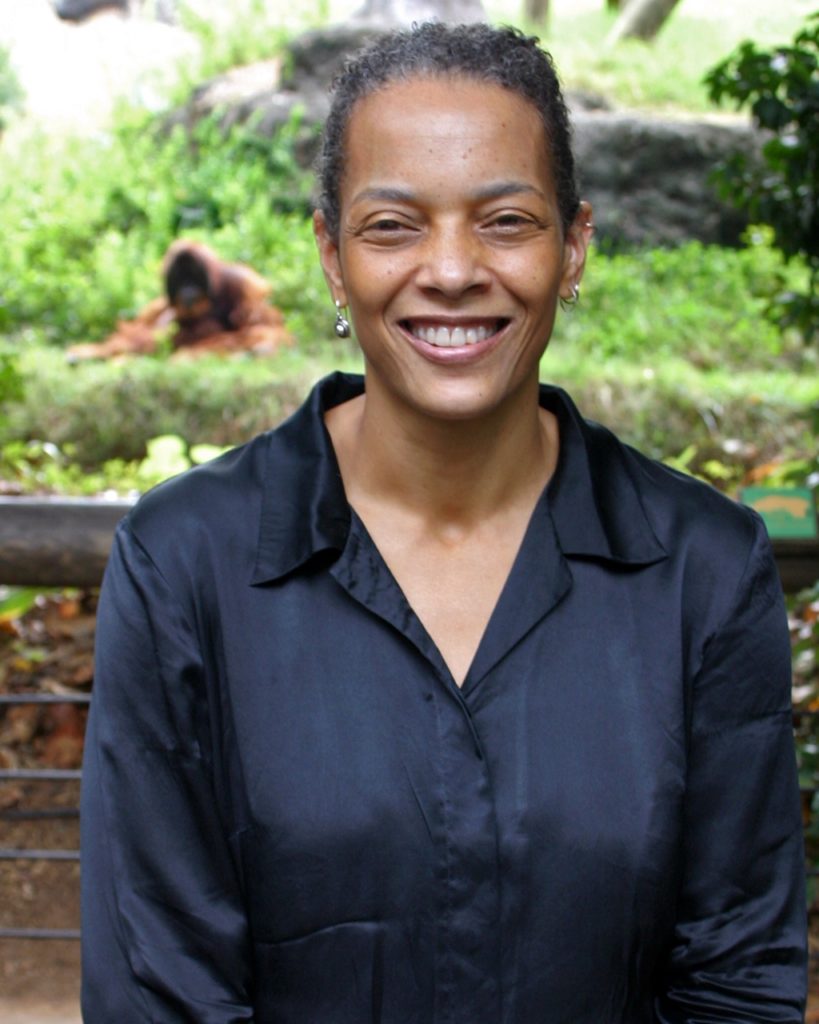
Inside Lori Perkins’s office at the Birmingham Zoo are figures and photos of orangutans, her favorite primate, the ones she has studied most in her nearly 30 years of zoological experience.
In November, Perkins assumed the role of deputy director at the Birmingham Zoo, where she will oversee the animal collections, veterinary, nutrition, and education teams, as well as monitor zoo operations, services, and maintenance.
“I’m still adjusting and getting to know everyone,” she said. “I’m excited about how broad it is. … I came up through the animal side of things, but I’ve always worked alongside the people running operations, running the rides, the maintenance guys. … I’m excited to have that team together in one unit.”
Throughout her career, Perkins has worked with zoos in cities across the nation, including Atlanta, Ga., Chicago, Ill., and New York City, N.Y. She also served as education and science director for Walt Disney Parks and Resorts Animal Kingdom.
When speaking of the Birmingham Zoo, she believes it is a gem that may not get the recognition it deserves in the broader zoo community: “I’m really excited to try to help make that name better known.”
Perkins is one of few African-Americans in the zoo industry.
“Historically, there have not been very many people of color. When I first started in the zoo profession, there were almost all men and hardly any people of color. … Now it seems like there are almost all women just in … my years in this business. … It’s very exciting to see,” she said, adding that the zoo community embraces diversity.
“Maybe it’s because we value biodiversity. We come from that background where we recognize the value of diversity in the animal kingdom. … We’re pretty open-minded and value diversity here.”
Animal Lover
Growing up in Boston, Mass., Perkins was not a stranger to dealing with animals.
“My dad was a big animal lover, so we had dogs, cats, rabbits, birds, guinea pigs, and everything all over the place all the time,” she said. “I think my dad kind of sparked my love for animals, … although I never thought of zoos as a career. Even though my whole career has been spent in zoos, it wasn’t what I had been planning. We grew up loving animals and having them a part of our world and our family.”
Perkins’s love of animals grew even more while she was studying psychology at the University of Massachusetts Amherst.
“It was experimental psychology, so I focused on animal behavior psychology, not analyzing people,” she said. “I thought I would end up doing rat lab research [for a career] because that’s what I did in school: study rats in a Skinner box,” a laboratory apparatus used to study animal behavior.
Her career choice changed when she found out there was a small colony of monkeys at school used for behavioral studies.
“I joined that lab and started studying [monkeys], then I was really, really hooked,” she said. “I decided that I wanted to continue studying primates and their social behavior. I wanted to study apes, but this was a colony of monkeys. I wanted to study gorillas, chimpanzees or orangutans.”
Zoo Atlanta
At that time, in the mid-1980s, the only apes available for that kind of lab study were in Georgia, so that’s where Perkins applied for graduate school. She was accepted at the Georgia Institute of Technology (Georgia Tech), where she studied under well-known animal-behavior psychologist, Terry Maple. This led to her first stint at a zoo.
Shortly after Perkins arrived in Atlanta, the Zoo Atlanta was named one of the 10 worst zoos in America. Then-Mayor Andrew Young called on Maple to correct the problems, and Maple brought Perkins along to handle animal records.
“That’s when I finally discovered zoos as a career,” Perkins said. “I started off as a registrar, [handling] … permits and shipping and that sort of thing. That avenue turned out to be the one I was going to stick with. I was in love with it the moment I found out about zoos. I was like, ‘OK, this is home. This is where I need to be.’”
As a graduate student, Perkins had to complete a research project where she started studying gorillas, but she was more intrigued by orangutans.
“I started noticing the orangutans at the other end of the building and thought they were pretty cool,” she said. “In fact, Oliver, [a 37-year-old male Sumatran orangutan who lives at the Birmingham Zoo], was the first orangutan outside of Atlanta that I ever studied.”
As part of her master’s thesis, Perkins was allowed to travel to the Birmingham Zoo to study Oliver, one of the oldest orangutans within the U.S. population. By the way, Oliver is still in Birmingham: in 2017, he received the first ever cardiac monitor implant in orangutans.
Bronx Zoo
After earning her master’s degree from Georgia Tech, Perkins continued to work at Zoo Atlanta until she got an offer to work at New York City’s famed Bronx Zoo.
“They were looking for a registrar,” she said. “I thought, ‘How cool is it that I get to work at the Bronx Zoo?’ It was a tremendous experience to be able to move to a zoo with that size and that history. I really learned a lot during my time there.”
Perkins enjoyed working at the Bronx Zoo, but she didn’t enjoy living in the Bronx. She returned to Georgia after a year to work with Maple again at Zoo Atlanta, where she worked in several different areas, assuming positions in research and conservation, as well as conservation technology, which involved building a new education center for Georgia.
“One of my projects [as the director of conservation technology] was to manage the distance-learning program and the education center,” she said.
Lincoln Park Zoo
Though her work in conservation technology was rewarding, Perkins said she felt disconnected from the animal side. Then she learned that Chicago’s Lincoln Park Zoo was looking for a curator of primates.
“I was at the Lincoln Park Zoo when they were designing and building what I still believe to be the premiere ape facility in North America, the Regenstein Science Center for African Apes,” she said. “In Chicago it’s very cold during the wintertime, so it had to be a largely indoor facility.”
Perkins helped with the design of the building and worked with architects and planners.
“Every day, we were on site with the construction guys. [We’d tell them], ‘Oh, I want this tree limb to go this way, not that way, and it needs to be made of this and this.’ … I got to see that project right through to the end. It was really, really fun.”
Though she enjoyed working in Chicago, Perkins realized that, even though she is originally from Boston, she had been converted to a Southerner. She again returned to Zoo Atlanta, where she handled collection management, guiding the entire animal population, not just the primates—and she moved up the ranks.
“I rose up to the vice president level, … [which] was wonderful because I got to lead a team of animal-care staff, the conservation programs, science programs and ultimately the education programs,” she said. “I got to be the leader of the mission side of the business, and that [can be fun because you get] to do all the really cool things zoos are intended to do.”
Disney’s Animal Kingdom
Her next stop was Disney’s Animal Kingdom, which was coming up on its 20th anniversary in 2018 and was seeking someone to fill the education and science director position.
Disney is a unique environment, Perkins said: “It’s very different from the traditional zoo experience. I was at the Animal Kingdom, but my job was to work with education strategy and welfare science for the entire company internationally.
“The very coolest part—and I’ll never be able to match this anywhere—[was that I oversaw] the animals-in-film-and-TV team, so any Disney production from the TV shows to any of the films, including animated films, Disney Jr., anything that involved animals, went through our team,” she said. “Even in an animated feature, Disney feels very strongly about presenting animals in the right light.”
Perkins gave an example: “Hyenas are always vilified and are always the bad guy. In the original ‘Lion King,’ they were the bad guys. What we were able to do was have them in the Disney Jr. ‘Lion Guard’ TV show, [in which] the hyena was the hero to show some actual qualities of hyenas and their value to the ecosystem and make people like hyenas, as well.
“I had so much fun doing this part of the job. I got to go be on set at various productions, read scripts in advance. You sign a lot of nondisclosure acts, but it was really fun because where else are you going to have that experience other than a place like Disney? That was really fun and valuable and expanded my experience and exposure to the influence that animals can have on society.”
Perkins missed working at a traditional zoo, though, and jumped at the chance to become the Birmingham Zoo’s deputy director.
“There is a lot of growth and potential here in Birmingham,” she said. “It’s exciting to me to be one of the drivers of that, not so much getting in on the ground floor but on the second floor. I’m really excited to work with Chris [Pfefferkorn, Birmingham Zoo president and CEO], and the rest of the team to see where we can go.”

